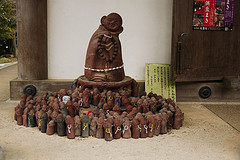Why is Kanji Kingdom in a Different Order from Jalup Beginner?
Learning kanji and then immediately being able to use them feels great. This is especially true when your method is learning kanji separately from your other studying. For example, when you see a kanji in Kanji Kingdom, you are learning an English keyword, and refreshing yourself on the English meanings of all the other kanji you’ve learned. But this isn’t engaging you in a lot of the sentences you are currently learning in Jalup Beginner.
Wouldn’t it be great if as you learned every Kanji Kingdom kanji, you were using them in Jalup Beginner?
This is something I actually tried to create, twice. For those of you that remember, there was originally a product on Jalup called “Kanji Assist.” It was a light version of what Kanji Kingdom would eventually become, where it gave you a single English keyword for every kanji. The kanji were exactly in the order of the kanji you saw in Jalup Beginner (and then Jalup Intermediate). Instant, connected exposure. All set, right?
Except people found Kanji Assist difficult to use because it had one big problem. You learned complex kanji right from day one. When I had tested out the thought of having the Kanji Kingdom order follow Kanji Assist, I ran into the same issue. The following two facts prevent that desired transition:
1. Difficulty kanji doesn’t equal difficult words.
2. Easy words don’t equal easy kanji.
The first 10 kanji of Kanji Kingdom
乙
一
人
入
八
七
十
丁
力
九
The first 10 kanji of Jalup Beginner
鈴
木
博
願
学
生
彼
英
語
一
Which looks like the bigger struggle?
Kanji Kingdom order is based on 3 principles
- Simpler kanji are easier to remember
- More difficult kanji are built from simpler kanji
- It is easier to remember more difficult kanji when you already know the simpler kanji parts that form them.
Kanji is a pain. The order makes a major difference. You don’t get the gratification of perfect unison with Jalup Beginner. However, you also don’t get the headache of memorizing kanji in a random order with difficult kanji mixed in all over the place.
You will still see many kanji you learned early on in Kanji Kingdom in Jalup Beginner (and Intermediate). It’s not an all or nothing game. I promise you’ll feel plenty of those real- use motivational moments.
Keeping it simple
Don’t worry about not being able to immediately use all the kanji you learn. You will be using every last one of them soon enough.
Founder of Jalup. iOS Software Engineer. Former attorney, translator, and interpreter. Still watching 月曜から夜ふかし weekly since 2013.





As someone who learned Kanji using the RTK method (Using Kanji Koohi website) before ever even hearing of Jalup, I am curious how you guys feel Kanji Kingdom compares to RTK. I mainly ask because I have a friend who is also starting to learn japanese and is about to enter the ‘kanji’ phase.
The thing that I loved about RTK that just seems to be missing in Kanji Kingdom is mnemonics. I realize they aren’t for everyone though.
Could anyone give me better insight on Kanji Kingdom vs RTK, especially as it relates to mnemonics?
Just to make things trickier, there is another good 3rd option.
1. Do Lazy Kanji (AJATT style)
2. Learn a bunch of Japanese, maybe 2 years worth
3. Do RTK, however this time using the Japanese you know, use Japanese on the front to trigger the Kanji your trying to recall
I think learning the kanji by stroke order is very logical, but it is not necessarily the best order to learn the kanji. Out of the first ten kanji, there is one, 乙, that is not really going to be encountered early on in your studies of actual sentences. I have been thinking about a way to order the kanji in a much more natural pathway, by going after the pictographs and ideographs that constitute the main radicals, and then it becomes easier to go into the phono-semantic compounds which comprise most kanji. Basically, the first 200-300 kanji would just set you up for everything else, which could be in the order that you encounter them. In that way, maybe learning 乙 would be best done immediately before you see it in a compound kanji, like 乾 (which you would learn in conjunction with the word 乾杯). I don’t know if I will ever have the time to make such a deck, since I have already gone through the entire Joyo Kanji.